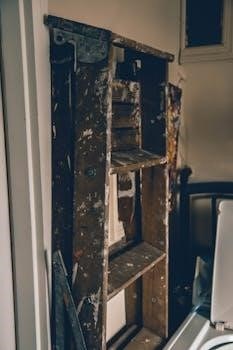
A home maintenance checklist PDF is a vital tool for homeowners․ It provides a structured approach to managing upkeep, ensuring that essential tasks are not overlooked․ This helps maintain the home’s condition․
The Importance of a Home Maintenance Checklist
A home maintenance checklist is crucial for several reasons․ Firstly, it helps in preventing costly repairs by identifying potential issues early on․ Regular checks can catch minor problems before they escalate into major, expensive fixes․ Secondly, using a checklist ensures that all areas of the home, both interior and exterior, receive the necessary attention․ This includes often-overlooked tasks like cleaning gutters or checking for leaks․ Furthermore, a structured checklist promotes a proactive approach to home care rather than a reactive one․ This proactive approach leads to better home management․ This, in turn, contributes to maintaining or even increasing the property’s value․ Finally, a checklist ensures a safer living environment, addressing potential safety hazards promptly․ Therefore, a home maintenance checklist is an essential tool for responsible homeownership․

Types of Home Maintenance Checklists
Home maintenance checklists come in various forms, including seasonal lists for spring, summer, fall, and winter, plus monthly task lists․ These ensure comprehensive home care year-round․
Seasonal Maintenance Checklists (Spring, Summer, Fall, Winter)
Seasonal checklists are crucial for addressing specific needs throughout the year․ Spring often involves checking for winter damage and preparing for warmer weather․ Summer tasks focus on maintaining systems like cooling and addressing outdoor upkeep․ Fall is the time to prepare for colder weather, including gutter cleaning and weatherproofing․ Winter checklists ensure protection from freezing temperatures, focusing on pipes and preventing roof damage․ These checklists are essential to keep your home in top condition, as they allow you to proactively manage challenges and prepare for the climate-specific demands of each season․ They also aid in spotting potential issues early, before they escalate into major, costly repairs․ By following a seasonal schedule, you can distribute the workload throughout the year․
Monthly Maintenance Tasks
Monthly maintenance tasks are essential for consistent home care․ These tasks often include testing smoke detectors, changing air filters, and inspecting for leaks․ Regularly checking grout and caulking prevents water damage․ Cleaning garbage disposals helps avoid clogs and odors․ Maintaining unused bathrooms can prevent future plumbing issues․ Monthly tasks also involve visual inspections, looking for any signs of damage or wear․ This proactive approach helps catch problems early, preventing larger issues․ Consistent monthly maintenance ensures that your home systems are functioning properly and extends the life of your appliances and structures․ Incorporating these tasks into a routine provides an easy way to maintain your home’s value and safety․ Regular attention is key․

Key Areas of Home Maintenance
Home maintenance involves several key areas․ These include exterior upkeep, interior systems, and appliance care․ Focusing on these ensures a well-maintained and safe living environment․ Consistent attention is essential․
Exterior Maintenance (Roof, Gutters, Foundation)
Exterior maintenance is crucial for protecting your home from the elements․ Regularly inspect your roof for any damaged or missing shingles, which can lead to leaks․ Gutter cleaning is essential, especially in the fall, to prevent clogs that cause water damage․ Ensure downspouts direct water away from the foundation․ Check your foundation for cracks or signs of settling, which can compromise structural integrity․ Look for any chipping paint or damaged siding, repairing them promptly to avoid further issues․ Seal any gaps to prevent pests from entering your home․ These exterior checks are vital for maintaining the home’s overall health and value, making it important to include them in your maintenance schedule․
Interior Maintenance (Plumbing, Electrical, HVAC)
Maintaining your home’s interior systems is vital for comfort and safety․ Regularly check plumbing for leaks under sinks and around toilets to prevent water damage․ Inspect electrical outlets and wiring for any signs of wear or damage․ Test smoke detectors monthly and replace batteries as needed․ HVAC systems should be serviced twice a year, including filter changes, to ensure efficient operation․ Check for clogs in plumbing, such as drains and disposals․ Inspect grout and caulking in bathrooms and kitchens and repair any cracks․ Address any unusual noises or smells from these systems promptly to prevent major issues․ These checks ensure a comfortable and safe living environment․
Appliance Maintenance
Regular appliance maintenance is crucial for their longevity and efficiency․ Clean dryer vents regularly to prevent fire hazards and ensure proper drying․ Inspect and clean refrigerator coils to maintain cooling efficiency․ Check washing machine hoses for leaks and replace them as needed․ Clean dishwashers regularly to prevent buildup of debris and odors․ Periodically inspect the oven and stove for any malfunctions and clean them thoroughly․ Follow manufacturer’s instructions for specific maintenance tasks for each appliance․ Maintaining appliances can also help reduce energy consumption․ By keeping your appliances in good working order, you can avoid costly repairs and prolong their lifespan․

Using a Home Maintenance Checklist PDF
Using a home maintenance checklist PDF involves downloading, printing, and regularly consulting the document․ This ensures all tasks are completed on time․ Customize the list to fit your home’s unique needs․
Downloading and Printing Checklist Templates
Obtaining a home maintenance checklist PDF is straightforward․ Numerous websites offer free templates suitable for various needs․ Begin by searching online for “free home maintenance checklist PDF․” Select a template that aligns with your preferences, such as seasonal, monthly, or specific maintenance categories․ Once you’ve chosen, download the PDF file to your computer․ Ensure you have a PDF reader installed․ After downloading, open the file and print it using your printer․ For enhanced durability, consider printing on thicker paper or laminating it․ Keep printed checklists in a visible, accessible location for easy reference․ Regularly checking and updating your printed checklist is essential for effective home maintenance management․
Customizing Checklists for Specific Needs
While standard home maintenance checklists are helpful, tailoring them to your specific needs enhances their effectiveness․ Begin by reviewing the generic template and identify areas that require modification․ Consider your home’s age, location, and unique features․ Add tasks relevant to your specific appliances, systems, and landscaping․ You can add or remove items, and adjust the frequency of checks․ For example, if you have a well, include well maintenance tasks․ If you live in an area with severe winters, add winter-specific maintenance․ Use digital tools like PDF editors or word processors to modify the downloaded checklist before printing․ This ensures a personalized, relevant, and efficient maintenance plan․

Benefits of Using a Home Maintenance Checklist
Using a home maintenance checklist helps prevent costly repairs by catching problems early․ It also maintains home value, and ensures the safety of the residents․ It provides a clear roadmap․
Preventing Costly Repairs
Regular home maintenance, guided by a checklist, is crucial in preventing expensive repairs․ By addressing minor issues promptly, you can avoid them escalating into major problems․ For example, catching a small roof leak early can prevent extensive water damage․ Similarly, regular checks of plumbing can identify and resolve minor leaks before they cause structural damage․ These proactive measures, facilitated by a maintenance checklist, save significant money and hassle in the long term․ Consistent upkeep of appliances, heating and cooling systems, and electrical systems also ensures they are running efficiently, reducing the chance of breakdowns․ Furthermore, preventative maintenance ensures the longevity of your home’s components․
Maintaining Home Value
A well-maintained home retains and often increases its value․ Using a home maintenance checklist ensures that your property remains in excellent condition, appealing to potential buyers if you decide to sell․ Regular upkeep, guided by a checklist, demonstrates to prospective buyers that the home has been cared for․ This includes addressing cosmetic issues, ensuring that all systems are in good working order, and preventing structural problems․ A home that looks well-kept and functions smoothly is more desirable and therefore worth more․ Consistent maintenance also prevents the deterioration of materials and components, ensuring they last longer․ This translates to fewer repairs and less replacement costs, preserving the home’s overall worth․ A detailed maintenance record, easily kept with a checklist, can further enhance value․
Ensuring Home Safety
Using a home maintenance checklist is crucial for ensuring the safety of your home and its occupants․ Regular checks, as prompted by the checklist, help identify potential hazards before they escalate into serious problems․ For example, testing smoke detectors and carbon monoxide detectors regularly is a critical safety measure․ Moreover, inspecting electrical systems and plumbing for leaks can prevent fires or water damage․ Checking for loose railings, uneven walkways, or damaged stairs helps prevent accidents․ A checklist ensures that these safety checks are performed routinely, reducing risks․ By following a checklist, you can also verify the proper functioning of safety equipment, such as fire extinguishers․ Adhering to a maintenance schedule improves your home’s safety, offering you and your family peace of mind․
Leave a Reply
You must be logged in to post a comment.